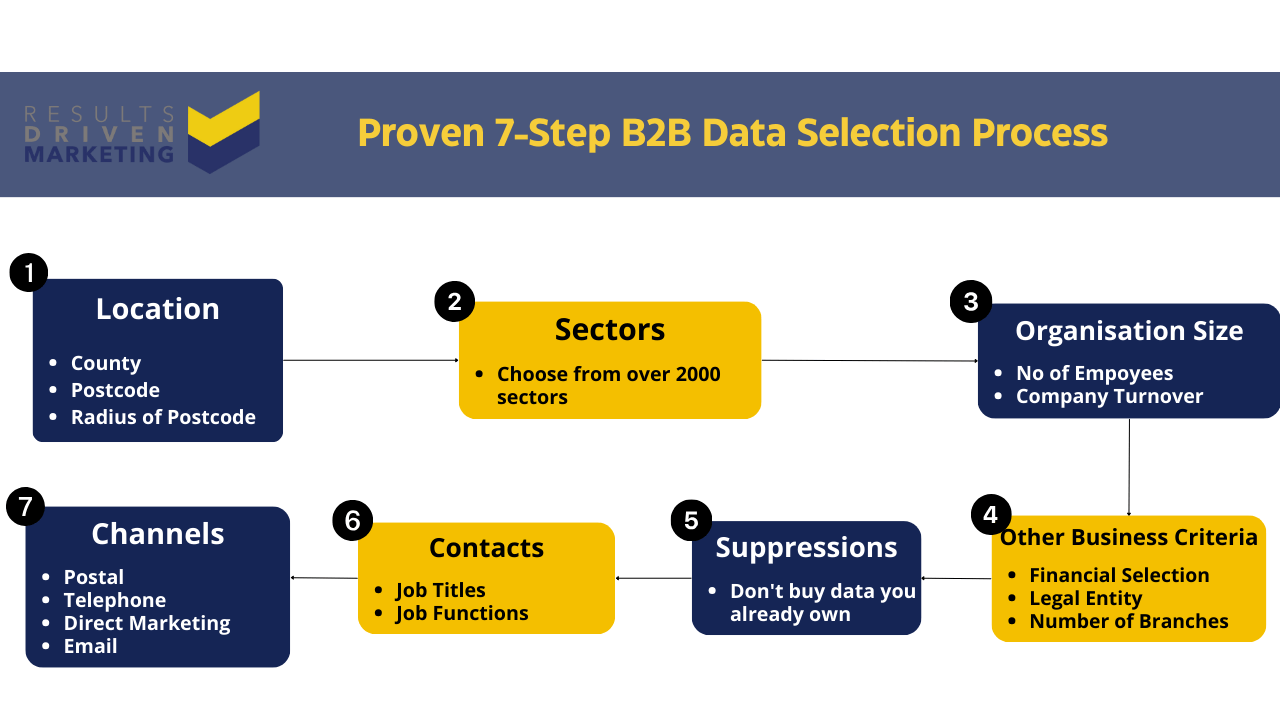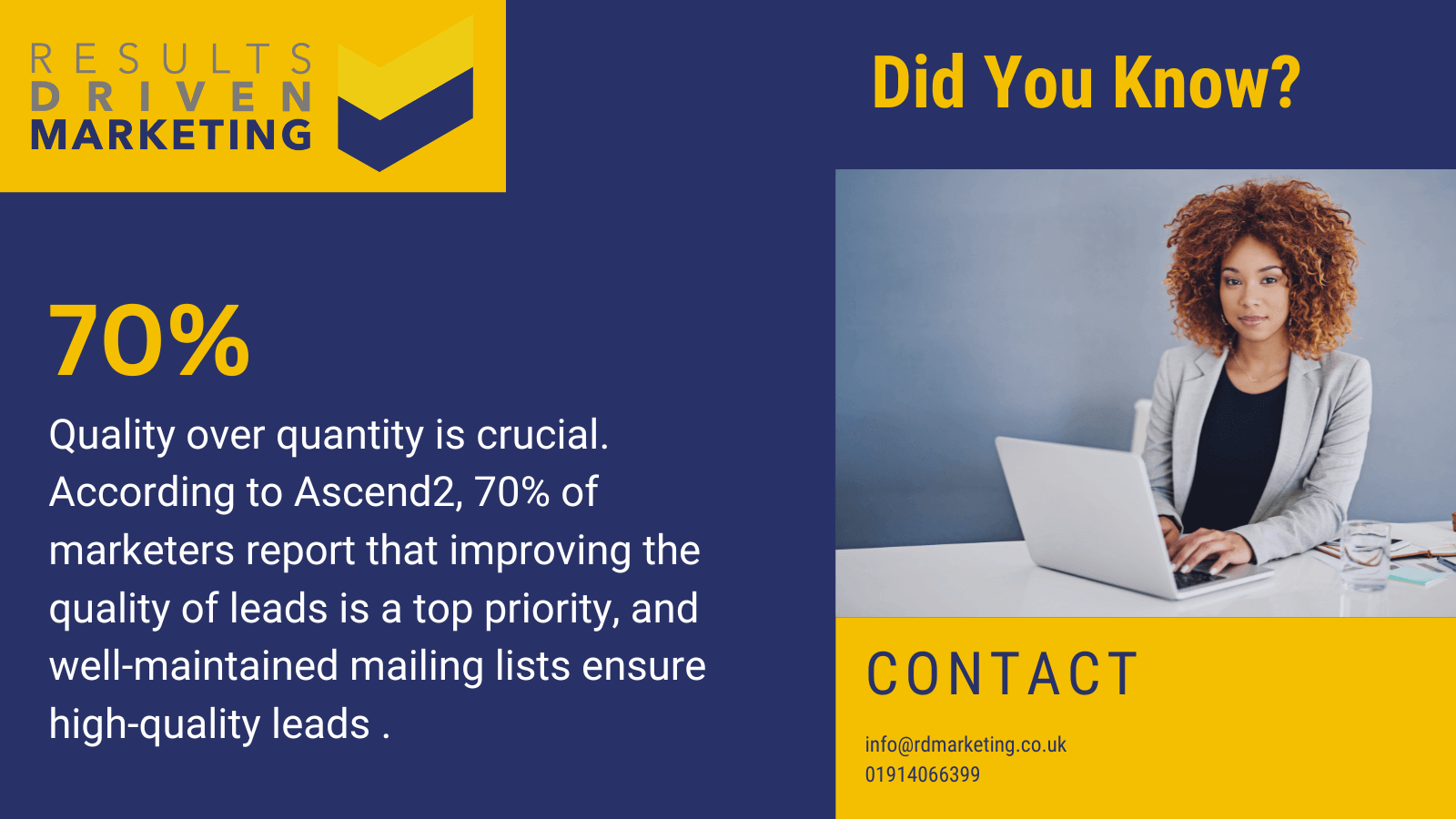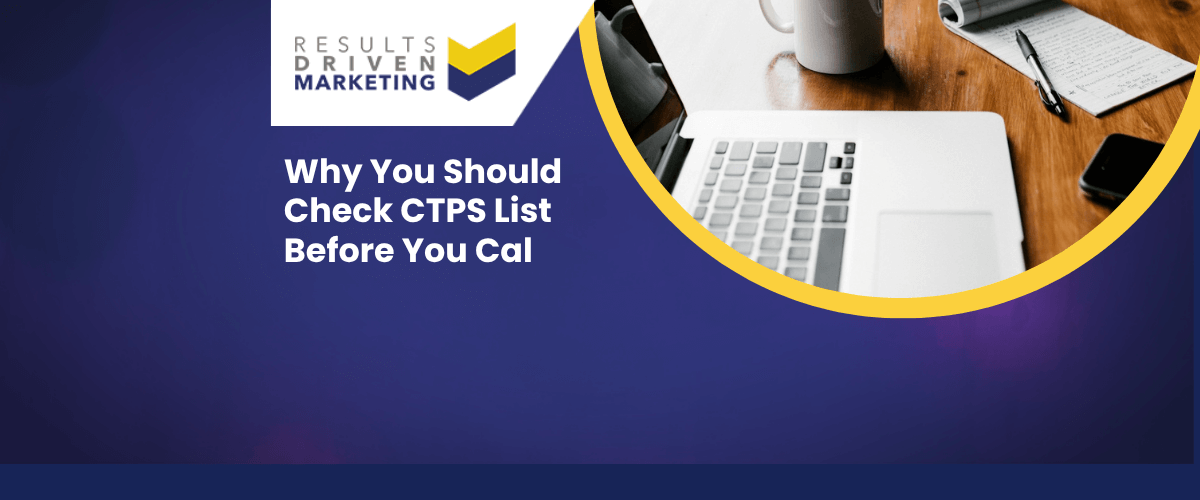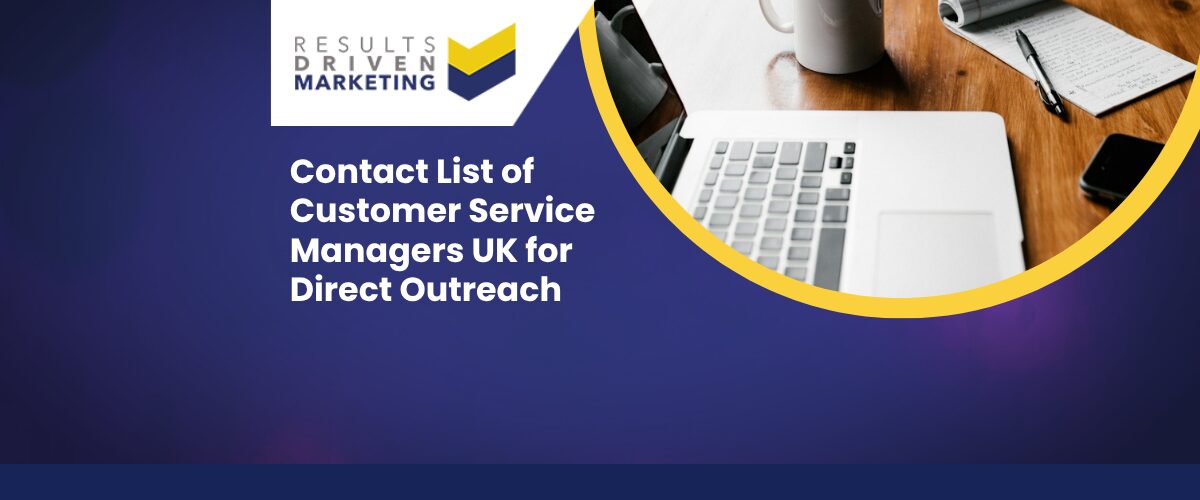
Nail Your Niche Using Mailing Lists for Targeted Marketing Strategies
Finding the right marketing strategy can be challenging. This is where targeted marketing strategies come into play. These strategies help businesses focus their efforts on a specific segment of the market, ensuring that their marketing messages reach the right audience.
By honing in on a niche, businesses can tailor their marketing efforts to meet the unique needs and preferences of their target customers, leading to higher engagement and better conversion rates.
Table of contents:
Brief Overview of Targeted Marketing Strategies
Targeted marketing strategies involve identifying a specific group of consumers and directing your marketing efforts towards them. This approach contrasts with mass marketing, where the goal is to reach as many people as possible. With targeted marketing, businesses can create more personalised and relevant marketing messages, which are more likely to resonate with their audience. This increases the chances of converting leads into customers and customers into loyal advocates.
Targeted marketing strategies can include a variety of techniques such as:
- Segmentation: Dividing the market into distinct groups based on demographics, behaviors, or other criteria.
- Personalisation: Customising marketing messages to address the specific needs and preferences of each segment.
- Positioning: Crafting a brand image and message that appeals to the target segment.
Importance of Niche Marketing in Today’s Competitive Landscape
Niche marketing is a subset of targeted marketing strategies that focuses even more narrowly on a specific segment of the market. In today’s competitive landscape, niche marketing is crucial for several reasons:
- Reduced Competition: By focusing on a specific niche, businesses face less competition compared to targeting a broader market.
- Higher Relevance: Marketing messages can be more relevant and tailored, leading to better customer engagement.
- Stronger Brand Loyalty: By addressing the unique needs of a niche market, businesses can build stronger relationships and foster brand loyalty.
- Efficient Use of Resources: Niche marketing allows businesses to allocate their resources more efficiently, maximising ROI.
Introduction to the Role of Mailing Lists in Targeted Marketing
Mailing lists are a powerful tool in executing targeted marketing strategies. A well-maintained mailing list allows businesses to reach their audience directly, with personalised and relevant content. Here’s how mailing lists play a crucial role in targeted marketing:
- Direct Communication: Mailing lists provide a direct line of communication with potential and existing customers, allowing for personalised and timely messages.
- Segmentation: Mailing lists can be segmented based on various criteria such as purchase history, preferences, and behavior, enabling highly targeted campaigns.
- Measurement and Optimisation: Email marketing platforms offer detailed analytics, helping businesses track the performance of their campaigns and make data-driven adjustments.
By effectively using mailing lists, businesses can ensure their marketing efforts are not just reaching the right audience but also making a significant impact. This article will delve deeper into how you can build and utilise mailing lists to nail your niche and enhance your targeted marketing strategies. Stay tuned as we explore the steps to create, maintain, and leverage mailing lists for maximum marketing success.
Understanding Targeted Marketing Strategies
Alright, let’s dive into the nuts and bolts of targeted marketing strategies. This is where the magic happens – when businesses truly understand their audience and tailor their efforts to meet specific needs.
Definition and Explanation of Targeted Marketing Strategies
So, what exactly are targeted marketing strategies? In simple terms, targeted marketing strategies are approaches businesses use to direct their marketing efforts towards a specific segment of the market. Unlike blanket advertising where the goal is to reach as many people as possible, targeted marketing is about precision. It’s like using a sniper rifle instead of a shotgun – you aim carefully and hit the bullseye.
Targeted marketing strategies involve identifying a group of potential customers who share common characteristics. These characteristics can be demographics like age, gender, and location, or psychographics like interests, behaviors, and values. Once you have your target segment, you craft marketing messages that resonate with this specific group.
Benefits of Targeted Marketing
Now, why should businesses bother with targeted marketing strategies? What are the benefits? Let’s break it down:
Higher Relevance and Engagement:
- When your marketing messages are tailored to the interests and needs of a specific audience, they are more likely to resonate. This means higher engagement rates, whether it’s through email open rates, click-through rates, or social media interactions.
Better Conversion Rates:
- With targeted marketing, you’re not just reaching a random audience; you’re reaching people who are more likely to be interested in your products or services. This translates to higher conversion rates, meaning more leads turning into actual customers.
Cost Efficiency:
- Targeted marketing allows you to use your marketing budget more efficiently. Instead of spending money on a broad audience, you focus your resources on those who are most likely to convert. This maximises your return on investment (ROI).
Improved Customer Retention:
- When customers receive marketing messages that feel personalised and relevant, they are more likely to stay loyal to your brand. This helps in building long-term relationships and enhances customer retention.
Competitive Advantage:
- By understanding and serving your niche better than your competitors, you can carve out a strong position in the market. This gives you a competitive edge that can be hard for others to replicate.
How Targeted Marketing Improves ROI
Let’s talk about the money – specifically, how targeted marketing strategies can significantly improve your ROI. Here are some key points:
- Efficient Use of Resources:
- With targeted marketing, every dollar spent is more likely to reach a potential customer who is interested in your offerings. This reduces wasted ad spend and ensures that your marketing budget is being used effectively.
- Higher Lifetime Value:
- Customers acquired through targeted marketing tend to have a higher lifetime value. Because your marketing is more relevant to their needs, these customers are more likely to make repeat purchases and stay loyal to your brand.
- Reduced Acquisition Costs:
- Targeted marketing strategies often lead to lower customer acquisition costs. Since your marketing efforts are more focused, it takes less time and money to convert leads into customers.
- Better Analytics and Optimisation:
- Targeted marketing allows for better tracking and analytics. By analysing the performance of your targeted campaigns, you can gather valuable insights and continuously optimise your strategies for even better results.
In summary, targeted marketing strategies are all about precision and relevance. By focusing your efforts on a specific audience, you can achieve higher engagement, better conversion rates, and ultimately, a much-improved ROI.
These strategies are essential for any business looking to make the most of its marketing efforts and truly connect with its audience. In the next section, we’ll explore the power of niche marketing and how it plays a crucial role in your overall marketing strategy. Stay tuned!
The Power of Niche Marketing
Alright, let’s get into the heart of what makes targeted marketing strategies so effective – niche marketing. If targeted marketing is about hitting the bullseye, niche marketing is about knowing exactly which bullseye to aim for. This is where businesses can truly shine by catering to a specific segment with precision and purpose.
Explanation of Niche Marketing
Niche marketing is essentially about zeroing in on a very specific segment of the market. Instead of trying to appeal to everyone, businesses that use niche marketing focus on a smaller, well-defined group of customers. These customers share common traits, needs, or interests that set them apart from the broader market.
Think of niche marketing as diving deep rather than spreading wide. You’re not just looking for potential customers – you’re looking for the right customers. This approach allows businesses to create highly tailored products, services, and marketing messages that speak directly to the unique needs of their niche audience.
Advantages of Focusing on a Specific Niche
Now, you might wonder, why go through the trouble of narrowing down your audience? Let’s break down the advantages of focusing on a specific niche:
Reduced Competition:
By targeting a smaller, more specific market, you face less competition. This gives you a better chance to stand out and dominate your niche.
Higher Customer Loyalty:
When you cater specifically to a niche market, you can build stronger, more personal relationships with your customers. This leads to higher loyalty and repeat business.
More Effective Marketing:
Your marketing messages can be highly specific and relevant, which resonates more with your audience. This increases the effectiveness of your campaigns and leads to better engagement.
Enhanced Brand Authority:
Focusing on a niche allows you to position your business as an expert or leader in that particular area. This enhances your brand authority and trustworthiness.
Better Use of Resources:
Instead of spreading your resources thin by trying to appeal to everyone, you can allocate your time, money, and effort more effectively by focusing on a specific niche.
How Niche Marketing Enhances Targeted Marketing Efforts
Niche marketing and targeted marketing strategies go hand in hand. When you know your niche, you can enhance your targeted marketing efforts in several impactful ways:
- Precision Targeting:
- With a well-defined niche, your targeted marketing strategies can be much more precise. You know exactly who you’re trying to reach, making your efforts more focused and effective.
- Customised Messaging:
- Niche marketing allows you to create highly customised marketing messages that speak directly to the pain points, desires, and needs of your target audience. This level of personalisation boosts engagement and conversion rates.
- Improved Customer Insights:
- By focusing on a specific niche, you can gather deeper insights into your customers’ behaviours, preferences, and needs. This data is invaluable for refining your targeted marketing strategies and making informed decisions.
- Higher Engagement Rates:
- Marketing messages that are tailored to a niche audience are more likely to resonate and engage. This leads to higher open rates, click-through rates, and overall better performance of your marketing campaigns.
- Enhanced Product Development:
- Understanding your niche helps in developing products or services that are perfectly aligned with your audience’s needs. This increases the likelihood of product success and customer satisfaction.
In conclusion, niche marketing is a powerful approach that enhances targeted marketing strategies by providing a clear focus and direction. By honing in on a specific segment of the market, businesses can create more effective, relevant, and engaging marketing efforts. This not only improves customer acquisition and retention but also maximises the return on investment. In the next section, we’ll explore how to build a mailing list for targeted marketing, a crucial step in implementing these strategies. Stay tuned!
Building a Mailing List for Targeted Marketing
Alright, let’s dive into the nuts and bolts of building a email list, which is an essential component of targeted marketing strategies. A well-crafted mailing list allows you to reach your niche audience directly and deliver tailored messages that resonate. Here, we’ll walk through the steps to create an effective mailing list, from identifying your target audience to choosing the right email marketing platform and strategies for collecting email addresses.
Steps to Create an Effective Mailing List
Creating a mailing list might seem daunting, but breaking it down into manageable steps makes it much more straightforward. Here’s how you can get started:
Identify Your Target Audience
Choose the Right Email Marketing Platform
Implement Strategies for Collecting Email Addresses
Identifying Your Target Audience
The first step in building a mailing list is to identify your target audience. This is crucial because your entire targeted marketing strategy hinges on reaching the right people. Here’s how to identify your target audience:
- Define Your Niche:
- Clearly outline the specific segment of the market you want to target. This could be based on demographics (age, gender, location), psychographics (interests, lifestyle, values), or behaviour (purchase history, website activity).
- Create Buyer Personas:
- Develop detailed profiles of your ideal customers. Include information like age, occupation, interests, challenges, and goals. This helps in tailoring your marketing messages to resonate with these personas.
- Analyse Your Current Customers:
- Look at your existing customer base to identify common characteristics. Use this data to refine your target audience and ensure you’re focusing on the right segment.
Choosing the Right Email Marketing Platform
Once you have a clear understanding of your target audience, the next step is to choose an email marketing platform that supports your targeted marketing strategies. Here are some factors to consider:
- Ease of Use:
- Choose a platform that is user-friendly and offers intuitive tools for creating and managing email campaigns.
- Segmentation Capabilities:
- Ensure the platform allows you to segment your mailing list based on various criteria. This is essential for delivering targeted and personalised messages.
- Automation Features:
- Look for platforms that offer automation features, such as drip campaigns and autoresponders. This can save you time and ensure timely communication with your audience.
- Analytics and Reporting:
- Choose a platform that provides detailed analytics and reporting tools. This helps you track the performance of your email campaigns and make data-driven decisions.
- Integration Options:
- Make sure the platform integrates with other tools and systems you use, such as your CRM, social media platforms, and website analytics.
Strategies for Collecting Email Addresses
Now that you’ve chosen your email marketing platform, it’s time to start building your mailing list. Here are some effective strategies for collecting email addresses:
Create High-Value Content:
- Offer valuable content such as eBooks, whitepapers, or exclusive reports that your audience finds useful. In exchange, ask for their email address.
Use Sign-Up Forms:
- Place sign-up forms on your website, blog, and social media pages. Make sure they are easy to find and fill out.
Leverage Social Media:
- Use your social media channels to promote your email list. Share links to your sign-up forms and highlight the benefits of subscribing.
Run Contests and Giveaways:
- Organise contests or giveaways that require participants to provide their email address. This can quickly grow your list while engaging your audience.
Offer Discounts and Promotions:
- Encourage sign-ups by offering exclusive discounts or promotions to your email subscribers. This provides an immediate incentive to join your list.
Utilise Pop-Ups:
- Implement exit-intent pop-ups on your website that prompt visitors to subscribe before they leave. Offer a compelling reason, such as a discount or free resource.
Collect Emails at Events:
If you participate in events or trade shows, collect email addresses from attendees who visit your booth. You can use a tablet or paper sign-up sheet.
By following these steps and strategies, you can build a robust mailing list that serves as the foundation for your targeted marketing strategies. Remember, the goal is to create a list of engaged subscribers who are genuinely interested in your products or services. This will enable you to deliver highly relevant and personalised marketing messages that drive engagement and conversions. Stay tuned for the next section, where we’ll discuss how to utilise your mailing list for effective targeted marketing.
Utilising Mailing Lists for Targeted Marketing Strategies
So, you’ve built a solid mailing list. Now what? The next step is to leverage that list to its fullest potential. Utilising mailing lists effectively is the key to successful targeted marketing strategies. In this section, we’ll cover four crucial aspects: segmentation, personalisation, automation, and crafting compelling content. Let’s get started!
Segmentation: How to Segment Your Mailing List for Maximum Impact
Segmentation is the cornerstone of targeted marketing strategies. By dividing your mailing list into smaller, more defined groups, you can tailor your messages to better meet the needs and interests of each segment. Here’s how to do it:
Demographic Segmentation:
- Divide your list based on demographic factors such as age, gender, income, and location. This allows you to create messages that resonate with different demographic groups.
Behavioural Segmentation:
- Segment your list based on customer behaviour, such as purchase history, website activity, and email engagement. This helps you target customers who are at different stages of the buying journey.
Psychographic Segmentation:
- Group your audience based on their interests, values, and lifestyle. This deeper understanding enables you to craft messages that align with their personal motivations.
Engagement Level:
- Separate your list based on how engaged subscribers are with your emails. For example, you can create different strategies for highly engaged subscribers versus those who haven’t opened your emails in a while.
Customer Journey Stage:
Identify where your subscribers are in the customer journey – whether they are new leads, repeat customers, or loyal advocates – and tailor your messaging accordingly.
By effectively segmenting your mailing list, you ensure that each group receives the most relevant and personalised content, which boosts engagement and conversion rates.
Personalisation: Techniques for Personalising Email Content
Personalisation goes hand in hand with segmentation in your targeted marketing strategies. It’s all about making your subscribers feel like you’re speaking directly to them. Here are some techniques to personalise your email content:
Use Subscribers’ Names:
- Addressing your subscribers by their first name in the email subject line and greeting can significantly increase open rates and make your emails feel more personal.
Tailor Content Based on Preferences:
- Customise email content based on subscribers’ preferences and past behaviours. For example, if a subscriber has shown interest in a particular product category, highlight similar products or related content.
Dynamic Content:
- Use dynamic content blocks to show different content to different segments within the same email. This allows for a high degree of personalisation without the need to create multiple emails.
Personalised Recommendations:
- Leverage data on past purchases and browsing history to recommend products or services that are likely to interest each subscriber.
Birthday and Anniversary Emails:
Send special emails to celebrate subscribers’ birthdays or the anniversary of their first purchase. Include personalised offers or discounts to make them feel valued.
Personalising your emails makes your targeted marketing strategies more effective by creating a deeper connection with your audience, leading to higher engagement and loyalty.
Automation: Using Email Marketing Automation to Streamline Efforts
Email marketing automation is a game-changer for targeted marketing strategies. It allows you to send the right message to the right person at the right time, without manual intervention. Here’s how to use automation to streamline your efforts:
Welcome Series:
- Set up an automated welcome series to greet new subscribers. Introduce them to your brand, highlight key products or services, and set the tone for future communications.
Drip Campaigns:
- Create automated drip campaigns to nurture leads over time. Drip campaigns deliver a series of emails based on specific triggers, such as sign-ups or downloads, guiding subscribers through the sales funnel.
Abandoned Cart Emails:
- Use automation to send reminders to customers who have left items in their cart without completing the purchase. Include personalised recommendations or discounts to encourage them to complete the transaction.
Re-engagement Campaigns:
- Automatically send emails to re-engage inactive subscribers. Offer incentives or exclusive content to draw them back in and rekindle their interest.
Behavioural Triggers:
Set up triggers based on subscriber actions, such as website visits, clicks, or downloads. This allows you to send timely, relevant emails that align with their current interests and behaviour.
Automation ensures that your targeted marketing strategies are consistent and efficient, freeing up time for you to focus on other important tasks.
Content: Crafting Compelling Email Content That Resonates with Your Niche
Finally, let’s talk about crafting compelling email content. Even the most well-segmented and personalised emails won’t be effective if the content doesn’t resonate with your niche audience. Here are some tips for creating engaging content:
Know Your Audience:
- Use your knowledge of your niche to create content that speaks directly to their needs and interests. Understand their pain points and how your products or services can solve them.
Strong Subject Lines:
- Craft attention-grabbing subject lines that entice subscribers to open your emails. Use personalisation, urgency, and curiosity to capture their interest.
Value-Driven Content:
- Provide value in every email. This could be in the form of helpful tips, exclusive offers, educational content, or entertaining stories. Ensure that every email has a clear benefit for the reader.
Clear Call-to-Action (CTA):
- Include a clear and compelling CTA that tells subscribers exactly what you want them to do next. Make it easy for them to take action, whether it’s making a purchase, downloading a resource, or signing up for an event.
Visual Appeal:
- Use high-quality images, videos, and graphics to make your emails visually appealing. A well-designed email is more likely to capture and hold your subscribers’ attention.
Consistent Branding:
- Maintain consistent branding throughout your emails. This includes your tone of voice, color scheme, and overall design. Consistency helps build brand recognition and trust.
Engaging Storytelling:
Use storytelling techniques to make your emails more engaging. Share customer success stories, behind-the-scenes looks at your business, or the journey of your products.
By focusing on these elements, you can craft email content that truly resonates with your niche audience, driving engagement and conversions. Utilising mailing lists effectively is a powerful component of targeted marketing strategies, enabling you to connect with your audience in meaningful ways.
Advanced Mailing List Strategies
Alright, let’s take your targeted marketing strategies to the next level with some advanced mailing list techniques. These strategies will help you optimise your email campaigns, make data-driven decisions, and effectively retarget your audience. Let’s dive in!
A/B Testing for Email Campaigns
A/B testing, also known as split testing, is an essential tool for refining your targeted marketing strategies. It involves sending two variations of an email to different segments of your audience to see which one performs better. Here’s how to implement A/B testing for your email campaigns:
Define Your Objective:
- Start with a clear goal. Are you looking to increase open rates, click-through rates, or conversions? Knowing your objective helps you determine what element to test.
Choose One Variable to Test:
- Focus on testing one variable at a time to accurately measure its impact. Common variables include:
-
-
- Subject lines
- Email content
- Call-to-action (CTA) buttons
- Send times
-
Create Two Versions:
- Develop two variations of the email, changing only the chosen variable. For example, if you’re testing subject lines, keep the content and layout identical in both versions.
Segment Your Audience:
- Split your mailing list into two groups. Ensure the segments are similar in size and characteristics to get reliable results.
Analyse the Results:
- After sending both versions, analyse the performance metrics. Look at open rates, click-through rates, and conversion rates to determine which version performed better.
Implement the Winning Version:
Use the insights gained from the A/B test to refine your future email campaigns. Implement the winning version across your entire mailing list.
A/B testing allows you to make data-driven decisions, optimising your targeted marketing strategies for maximum impact.
Analysing Email Performance Metrics
Understanding the performance of your email campaigns is crucial for continuous improvement. By analysing key metrics, you can gain insights into what’s working and what needs adjustment. Here’s how to analyse email performance metrics effectively:
Open Rate:
- The open rate indicates how many recipients opened your email. A high open rate suggests that your subject line and sender name are compelling. To improve open rates, focus on crafting engaging subject lines and ensuring your sender name is recognisable.
Click-Through Rate (CTR):
- CTR measures the percentage of recipients who clicked on a link within your email. This metric shows how effective your email content and CTAs are. To boost CTR, ensure your content is relevant and your CTAs are clear and enticing.
Conversion Rate:
- The conversion rate tracks how many recipients completed the desired action, such as making a purchase or filling out a form. High conversion rates indicate that your email content, CTAs, and landing pages are aligned and effective.
Bounce Rate:
- The bounce rate shows the percentage of emails that were not delivered. A high bounce rate can harm your sender reputation. Regularly clean your mailing list to remove invalid or inactive email addresses to maintain a low bounce rate.
Unsubscribe Rate:
- This metric tells you how many recipients opted out of your mailing list. While some unsubscribes are normal, a high rate may indicate that your content is not meeting subscribers’ expectations.
Spam Complaints:
Monitor the number of spam complaints to maintain a healthy sender reputation. High spam complaints can result in your emails being marked as spam, reducing deliverability.
By regularly analysing these metrics, you can fine-tune your targeted marketing strategies, ensuring your emails are engaging and effective.
Retargeting Strategies Using Mailing Lists
Retargeting is a powerful strategy that allows you to re-engage potential customers who have shown interest in your products or services but haven’t converted yet. Using your mailing list, you can implement effective retargeting strategies to boost conversions. Here’s how:
Identify Retargeting Opportunities:
- Analyse your email metrics and website data to identify potential retargeting opportunities. Look for subscribers who:
-
-
- Opened your emails but didn’t click through
- Clicked through but didn’t complete the desired action
- Abandoned their shopping carts
-
Segment Your List for Retargeting:
- Create specific segments based on the identified opportunities. For example, you can have segments for:
-
-
- Cart abandoners
- Inactive subscribers
- Visitors who viewed specific products
-
Craft Targeted Retargeting Campaigns:
- Develop tailored email campaigns for each retargeting segment. For cart abandoners, send reminder emails highlighting the items left in their cart and offer incentives like discounts or free shipping. For inactive subscribers, create re-engagement emails offering exclusive content or special offers.
Use Dynamic Content:
- Incorporate dynamic content in your retargeting emails to make them more personalised and relevant. For example, show recently viewed products or related items based on their browsing history.
Leverage Automation:
- Set up automated retargeting workflows to ensure timely communication. Automation ensures that retargeting emails are sent based on specific triggers, such as cart abandonment or inactivity.
Track and Optimise:
- Monitor the performance of your retargeting campaigns and adjust based on the results. Use metrics like open rates, click-through rates, and conversion rates to gauge effectiveness and make necessary improvements.
Retargeting with mailing lists allows you to re-engage interested prospects and guide them towards conversion, enhancing the effectiveness of your targeted marketing strategies.
Conclusion
Alright, we’ve covered a lot of ground on how to nail your niche using mailing lists for targeted marketing strategies. Let’s recap the key points and drive home the importance of implementing these strategies for your business success.
Recap of the Key Points Discussed
Understanding Targeted Marketing Strategies:
- We explored the definition and benefits of targeted marketing strategies, highlighting how they help businesses focus their efforts on specific segments to increase engagement and conversions.
The Power of Niche Marketing:
- We delved into the advantages of niche marketing, explaining how focusing on a specific niche reduces competition, enhances relevance, and builds stronger customer loyalty.
Building a Mailing List for Targeted Marketing:
- We provided a step-by-step guide to creating an effective mailing list, from identifying your target audience to choosing the right email marketing platform and employing strategies to collect email addresses.
Utilising Mailing Lists for Targeted Marketing Strategies:
- We discussed the importance of segmentation, personalisation, automation, and crafting compelling content to make the most out of your mailing list for targeted marketing.
Advanced Mailing List Strategies:
- We covered advanced techniques such as A/B testing, analysing email performance metrics, and implementing retargeting strategies to optimise your targeted marketing efforts.
Encouragement to Implement the Strategies Outlined
Implementing these targeted marketing strategies might seem like a lot of work, but the payoff is worth it. By focusing on building and utilising your mailing lists effectively, you can create highly personalised and engaging marketing campaigns that resonate with your niche audience. Here are a few steps to get started:
- Start Small: Begin by segmenting your existing mailing list and testing different strategies to see what works best for your audience.
- Use Analytics: Pay close attention to your email performance metrics to understand what’s working and where there’s room for improvement.
- Experiment and Optimise: Don’t be afraid to experiment with different approaches and continuously optimise your campaigns based on the data you gather.
Final Thoughts on the Importance of Targeted Marketing Strategies and Mailing Lists
In today’s competitive market, businesses that utilise targeted marketing strategies effectively stand out. Mailing lists are a powerful tool in your marketing arsenal, allowing you to reach your audience directly with messages that are relevant and personalised.
By focusing on niche marketing, segmenting your audience, and continuously refining your approach through testing and analysis, you can achieve higher engagement rates, better conversions, and ultimately, greater ROI.
The importance of targeted marketing strategies and well-managed mailing lists cannot be overstated. They provide the foundation for building meaningful connections with your audience and driving sustained business growth. So, take the insights and strategies we’ve discussed, implement them with care, and watch as your marketing efforts become more impactful and successful.
Thank you for joining us on this journey through the world of targeted marketing strategies. Here’s to nailing your niche and achieving marketing success!
Who are we?
Dedicated to lead generation, Results Driven Marketing provides myriad services SMEs can trust to deliver results.
Our marketing lists are guaranteed accurate to industry high standards, and GDPR compliant and our experience team means that if you are looking to buy data, they make them totally bespoke and highly relevant whether you are looking for email lists, direct mailing lists or telemarketing lists.
Our email marketing software is highly rated. Responder provides the automation tools you need to put your marketing on autopilot.
We also supply email marketing solutions with our email marketing platform.
Call us today on 0191 406 6399 to discuss your specific needs.
Results Driven Marketing
info@rdmarketing.co.uk
0191 406 6399








